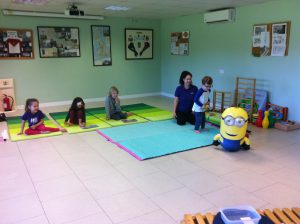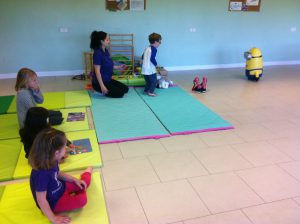What do you see?
As Conductors or staff working within Conductive Education what we see when we watch a child play, interact, move may be (is!) very different from what others observe. But what DO others observe in our sessions? What do people notice/ take away when they see photos of Conductive Education sessions and activities on Facebook / our website?
I therefore put this question to you (parent, family member, friend, professional, fundraiser…..) what do YOU see in these photos?
A group of children enjoying playing with Kevin our remote control Minion? Good waiting / turn taking? Fun?
Maybe you see the encouragement and smiles on their faces as they cheer on their friend operating the minion?
And the concentration on his as he uses the remote to drive the minion?
Do you see the balance and effort it takes to maintain a side sitting position?
Do you notice his standing position? Feet flat – heels down. Keeping his balance and his tall standing position.
Not just keeping his balance and his standing position but keeping his balance and standing position whilst his attention is on the Minion – thinking about where he wants to drive it to – which buttons he needs to press – which hand and which fingers on which hand does he need to use to send him the correct way – maintaining his grasp on the remote while using individual fingers to press the buttons, can he avoid the table (spatial awareness – tricky enough when it is your own body but thinking about Kevin – even trickier!) – the list goes on!
As this is just a photo (or 2!) you can’t hear the encouraging shouts from his friends – turn left – turn right – forwards – backwards – go towards the window! The giggles and the cheering when he managed a donut! Encouragement, learning, spacial awareness, enthusiasm, friendship, sharing and yes fun!
As this is just a photo you can’t see each child standing themselves up from the floor to take their position to be driver – this may be independently or this may be a skill they are learning and require facilitation to do but it is achieved (not done for them but achieved). There is a purpose to the activity, a reason to try, a reason to perservere. It takes a lot more physical effort for a child or adult with a neurological movement disorder to complete any movement than the average person. It also takes a lot more conscious though and mental effort – problem solving, co-ordination, movement planning and perserverance.
What did each of these children come away from this activity thinking?? Hopefully not about all of the things listed above or of the thought and expertise of the staff to create the right atmosphere and learning environment, the ever changing levels of verbal and manual facilitation and teaching of physical skills – but instead the overall feeling of fun, a positive experience of maintaining their sitting and standing, a feeling of having learnt new skills (driving a giant Minion is tricky!) the pride at having achieved everyday movement activities (such as standing up from the floor) the fun of playing with friends – of not being the slowest or getting left behind but just having fun, being completely included and their presecence and input into the game enjoyed and valued. Maybe they just take the feeling of a good time home or maybe they are able to verbalise that they could stand all by themselves while they played or that they managed to use both hands on the remote and make Kevin do a donut! Either way this positive feeling, confidence and the motivation to try will carry with them along with the physical skills they have learnt.


